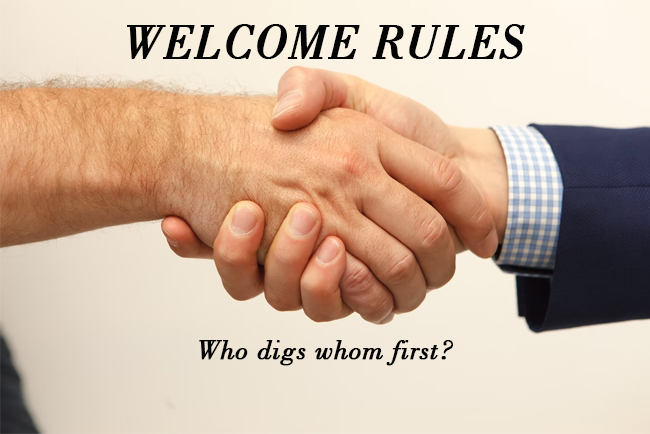Perfect Your Professional Greeting Etiquette With 3 Basic Welcome Rules
A perfectly shaped greeting is the first business card and is crucial for a pleasant first impression. But how do you greet your counterpart correctly?
Unfortunately, there are some pitfalls at work that you have to overcome when greeting people. Who shakes hands with whom first?
What do you say about it and when will the business card be handed over? To move safely on the social floor, you should know the most important etiquette rules, conventions, and greeting formalities. Here you are…

Greeting: 3 basic rules
Some people seem to succeed with ease, for others, it takes effort and training: a confident and confident appearance with a perfect greeting. Don’t let that blow you away. Greeting others is not rocket science and is not always as formal as it seems at first glance.
Every encounter – whether between friends or strangers – begins with a friendly greeting. Often a brief nod or a handshake is enough. Especially if both have known each other for a long time. The three most important basic rules of greeting apply here:
Who greets first
It always greets first who enters a room (office, conference room, elevator, waiting room …). This applies regardless of the hierarchy in the company. When the boss enters a room, he should briefly greet those already present. If you come into a room where several people are already waiting, there are different scenarios:
- Greet the host first: if there is a host, greet them first. At the same time, you can thank me for the invitation here.
- Greet acquaintances first: If a clear host is missing and you only know one of those present, greet them first. Your contact should then introduce you to the others present. In a sense, the most senior person in the room has the privilege of getting to know you.
- Say hello in turn: If you don’t know anyone present and cannot identify a ranking, say hello to those present one after the other. As you greet several guests in a row, you should repeat your name from time to time so that the last guests you greet also know who they are dealing with.
If the encounter is by chance – for example in the hallway – the person who sees the person opposite greets first. These rules of greeting apply to both business and private meetings.
Who will be greeted first?
There is a special feature in the job: Here, the lower-ranking person always greets the higher-ranking person first. In a business meeting or at a business dinner, the lady is not necessarily greeted first, but the highest-ranking person in the room and then everyone else in the descending hierarchy (if this is known).
Anyone who cannot determine a ranking in the round welcomes everyone in turn, as mentioned above. The well-known rule that women are always greeted first does not apply in professional life. Nevertheless, this order of greetings is widespread, often accompanied by a short comment such as “Ladies first”.
Exception: social events. No rule without exception. On social occasions, preferably in the evening, the order of precedence is lifted, here again, men greet women first. Even if the occasion has a professional background. If couples meet, first the women, then the men, the women, and then the men greet each other.
This formal order of greeting can also be changed among good friends or acquaintances. Here it is often the gentlemen who greet each other’s partner first.
How do you greet?
A greeting can be very simple: “Hello, Ms. Philips”. And of course, the person who greets them expects to be greeted back immediately afterward. The basic rule for this is: If possible, reply to the greeting in the same formal wording.
This is less about the exact words and more about the formality: So you shouldn’t answer a formal “Hello…” with a sloppy “Hello…”. If you are greeted verbally, it is also inappropriate to just nod in response to the other person.
7 tips for better greetings
Of course, a friendly greeting always has two intentions: You want to appear sympathetic – and at the same time appear trustworthy. If you stick to the above conventions, you are already well on your way. To be completely convincing with the greeting, there are additional tips.
High-ranking politicians regularly provide good examples of successful appearances. These radiate self-confidence and power as soon as they enter a room. However, you don’t have to become president to convince from the first moment. These little welcoming tips and tricks will work for everyone:
Radiate self-confidence
Those who feel comfortable in their skin also radiate that. Choose an outfit that makes you feel good and confident. Also, think positively about yourself, the meeting, and the potential acquaintances and opportunities that arise from it. A confident greeting appears confident and professional.
To have a goal
Enter an event and stand at the door for the first few minutes, unsure and seeking help. A successful greeting looks different. Therefore, when you enter a room, you should have a goal in mind from the start that you can pursue.
Greet those present and seek direct contact with interesting people with whom you would like to talk. Those who know their goal with and after the greeting automatically appear more convincing and are better perceived.
Seek eye contact
Always look your counterpart in the eye when greeting them. This is not just a sign of politeness and respect – eye contact also conveys credibility, as someone who has something to hide usually avoids eye contact. However, a look that is too intense can be interpreted as aggressive. Ideally, eye contact, therefore, lasts no longer than 3.3 seconds.
Lower voice
Our voice is not only a unique identifier but also an authentic and intimate calling card of our personality. With the help of our voice, we largely determine how we affect others. Even intonation and breathing trigger sympathy:
This is related to the so-called psychorespiratory effect. We perceive deep voices to be consistently more pleasant and personable, their wearers are considered confident, competent, and virile. Always greet your counterpart in a calm, relaxed, and as deep voice as possible.
Maintain body tension
Our body language subtly shapes the first impression of the greeting. If words and body language do not match, we immediately feel disturbed. Conversely: if you show presence and certain body tension, you are signaling your counterpart with full attention status, and strength at the same time.
Gestures calm down
Anyone who feels insecure tends to shrink visually. This can also be seen in the gestures made during a conversation. Shy and insecure conversation partners can often be recognized by the fact that they either gesticulate very hectically or not at all.
However, if you want to convince your counterpart, you should use slow and large gestures. You show self-confidence, status, and assertiveness. Another positive aspect: gestures relieve the cognitive system. They help to organize your thoughts and avoid unnecessary pauses, which are often filled with an “um”.
Smile a lot
And very important: Always smile when you do it. Nothing is as open and personable as an honest smile when I greet you. It connects people immediately, lifts the mood, and enables a good start to the conversation.
Read also: 155+ Smile Captions for Instagram posts
Handshake in greeting?
In many cases, the greeting includes a handshake. A matter of course where things can go wrong. The following applies: a handshake lasts no longer than three to four seconds. Longer handshakes are reserved for close friends. And: Please never shake it! Shaking hands is taboo.
Those who meet give and shake hands without moving wildly up and down. An etiquette of greetings lurks here in the order already described above: In business life, it is always the higher-ranking person who decides whether to shake hands with his counterpart.
So if you enter a room (for example an elevator) as a lower-ranking person, say hello first. But initially only verbally (or by nodding the head). The higher-ranking officer then decides whether he or she extends his hand to return the greeting. Therefore, please never run towards others with an outstretched hand – faux pas!
The host is an exception. Once you have been invited, you are practically the highest-ranking person in the room and you, as the host, are expected to welcome your guests with a handshake. However, here too – if the guests do not appear one by one – the highest-ranking guest comes first.
But there is more to the gesture than many think: the handshake is not just a mere greeting – it is a non-verbal signal of who you are dealing with. After all, the handshake is the first physical encounter between two people. And such touches – even if they are brief – have a great effect.
Even more:
They say something about us. Several variables play a role, which we – mostly unconsciously – analyze immediately:
- Strength: firm or slack?
- Texture: rough or soft?
- Temperature: cold or warm?
- Humidity: wet or dry?
- Handle: full or partial?
- Duration: short or long?
- Speed: slow or fast?
- Complexity: press or shake?
- Eye contact: none or long?
Because the handshake should always demonstrate trustworthiness, it should be definite. A classic recommendation is not to hand over “dead fish”. So neither hold out a spoonful hand and let it squeeze nor offer a wet hand. So that the handshake makes the right impression when greeting, you should avoid these absolute no-gos:
Damp hands: if you are clever, you carry a handkerchief in your trouser pockets and can dry your hands on it unnoticed. Otherwise, discreetly wipe it on your body.
Vice: It is also unfavorable if you have a handshake like a vice. Shaking your hand briefly and vigorously is ok, but then let go again immediately. You don’t have to try to break your opponent’s hand with all your might.
Slack fingers: the other extreme is just as unfavorable; Anyone who has a slack handshake and the hand may only partially reach with the fingertips is uncomfortable.
Clasped hand: With the correct handshake, only one hand is stretched out; embracing the other is perceived as a gesture of dominance, as is the grip on the shoulder, and is therefore not appropriate.
Long shaking: Under no circumstances should the hand be shaken back and forth: a short, single up-and-down movement is sufficient.
Hand hidden: The other hand should never be in your pocket! That seems too casual and could be interpreted as a sign of a lack of respect.
Welcome, hug?
“Come on, let yourself be hugged!” – The hug is much more emotional than a handshake and a special kind of greeting ritual. It is usually reserved for close friends and acquaintances. At least in the Western cultural area. In other cultures, the hug is as natural as the handshake is with us.
So it depends on the context. However, not everyone feels comfortable being hugged. Those who prefer to keep their distance in business contact, find the current situation unsuitable or are simply a less emotional person do not have to accept the offer of a hug.
As soon as you recognize the intention of the other person, hold out your hand for a traditional handshake in good time. Everyone should understand the hint. This leaves the other person with the opportunity to adjust to this body language answer without losing face.
For the very stubborn and insensitive there is still alternative two: Put a defensive hand in front of the upper body and say: “We don’t know each other well enough for this – but I’ll be happy to shake hands!”
Welcome business card?
Business cards are usually exchanged at business meetings, sometimes also at job interviews (but more at the management level). The exchange of business cards is a typical greeting ritual and is just as much a part of the introduction ceremony as the small talk afterward.
However, in addition to the name and function of the cardholder, the business card also contains their contact details. That makes them – symbolically – a personal gift and vote of confidence. For this reason, some etiquette rules and greeting conventions have also been established here, which must be observed:
When? In business life, the business card is presented at the beginning of a visit or conversation – shortly after the verbal greeting with a handshake.
Who? Usually, the guest gives his card first. Only then does the host hand over his card in exchange. Otherwise, the business rule applies again: the person with the highest ranking hands over their card first.
As? The card is always handed over with eye contact – in this country one hand is enough, in Asia, the business card is handed over with both hands. However, it would be grossly impolite if you received your counterpart’s business card to slip it into your pocket without being seen.
Always take some time to study them – if only because of possible (nobility) titles with which you have to address your counterpart. Later, carefully stow the card (appreciation!) In your breast pocket or handbag. Never in your pocket.
What other readers have read







